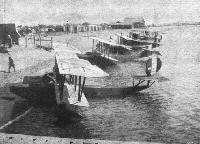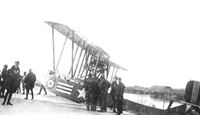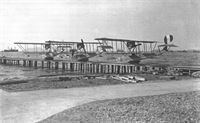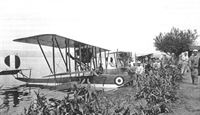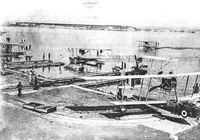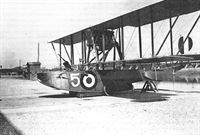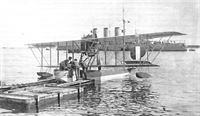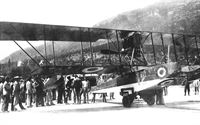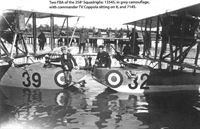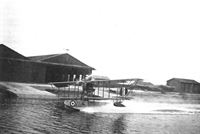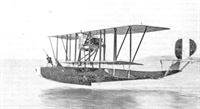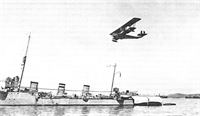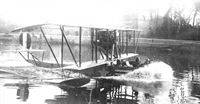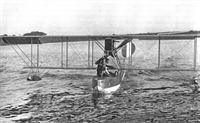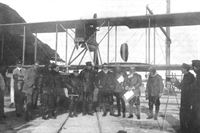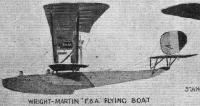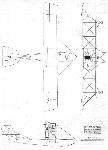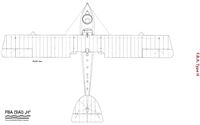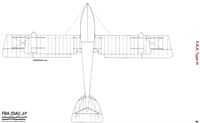
Описание
Страна: Франция
Год: 1916
Летающая лодка
В.Обухович, А.Никифоров Самолеты Первой Мировой войны
Лучшей летающей лодкой, созданной фирмой, была FBA Н. Она представляла собой значительно переработанную лодку "Левек". Модернизации подверглись корпус лодки, бипланная коробка и хвостовое оперение. Экипаж состоял из трех человек В качестве силовой установки использовались двигатели Клерже или Испано-Сюиза 8Аа (150 л. с). Было значительно усилено вооружение: в носовой части лодки и в задней кабине позади винта размещались турельные пулеметные установки. Лодки широко применялись французской, итальянской и бельгийской морской авиацией для патрулирования прибрежных районов и борьбы с подводными лодками. Всего было произведено около 2000 экземпляров FBA H, из них 982 лодки по лицензии выпустила итальянская компания "Савойя". Они были оснащены двигателем Изотта-Фраскини V4B (150 л. с.) и 7,5-мм пулеметом "Фиат".
Очередной (и последней периода войны) модификацией летающих лодок стала F.B.A. S. Она отличалась измененным корпусом. Модернизировано было и хвостовое оперение: на лодке установили киль с аэродинамически компенсированным рулем направления. Самолет оснащался двигателем Испано-Сюиза 8В (200 л. с). Кроме Франции, F.B.A. S состояли на вооружении морской авиации США и Бельгии, а в послевоенный период - в Югославии.
Технические данные F.B.A. H
Двигатель 1 x Испано-Сюиза 8Аа (150 л. с.)
Размеры:
размах х длина х высота 14,12 х 9,92 х 3,10 м
Площадь крыльев 40 м2
Вес:
пустого 984 кг
взлетный 1420 кг
Максимальная скорость 150 км/ч
Потолок 4900 м
Дальность 450 км
Вооружение:
стрелковое 1 х 7,7-мм турельный пулемет "Льюис"
бомбовое 70 кг
Экипаж 3 чел.
Описание:
- В.Обухович, А.Никифоров Самолеты Первой Мировой войны
- J.Davilla, A.Soltan French Aircraft of the First World War (Flying Machines)
- G.Swanborough, P.Bowers United States Navy Aircraft Since 1911 (Putnam)
- E.Hauke, W.Schroeder, B.Totschinger Die Flugzeuge der k.u.k. Luftfahrtruppe und Seeflieger 1914-1918
- J.Davilla Italian Aviation in the First World War. Vol.2: Aircraft A-H (A Centennial Perspective on Great War Airplanes 74)
- Журнал Flight
Фотографии
-
D.Mechin - Foreign Fronts of the French Air Force 1914-1919 /Aeronaut/
FBA Hispano 150 hp (type H) no 308 from CAM Venise flown by enseigne de vaisseau Jean Roulier, San Andrea Island, August 1916. Roulier was killed in this plane with his observer, quartier-maitre Auguste Costerousse.
-
D.Mechin - Foreign Fronts of the French Air Force 1914-1919 /Aeronaut/
FBA Hispano 150 hp (type H) n°310 from CAM Venise flown by second maitre Jacques Dudos, San Andrea Island, August 1916. Piloted by second maitre Jacques Dudos with quartier-maitre August Le Men as observer, this flying boat was shot down by Banfield but survived and was towed back to Venice. After repairs, it flew again with the nickname “Chichourlette comes back anyway"
-
D.Mechin - Oriental Adventures of the French Air force 1914-1918 /Aeronaut/
FBA 150 hp Hispano (Type H) no 363, CAM Corfou, Spring 1918.
-
D.Mechin - Oriental Adventures of the French Air force 1914-1918 /Aeronaut/
FBA 150 hp Hispano (no 648), CAM Plateali, Summer 1917.
-
R.Gentilli - Italian Aviation Units in the First World War. Vol.4 /Aeronaut/ (4)
F.B.A.Type H #203, Stazione Idrovolanti Venezia
-
R.Gentilli - Italian Aviation Units in the First World War. Vol.5 /Aeronaut/ (5)
FBA H #4261, 10a Sezione FBA, Terranova Pausania, February 1918
-
R.Gentilli - Italian Aviation Units in the First World War. Vol.4 /Aeronaut/ (4)
FBA Type H #4324, 252a Squadriglia, Stazione Idrovolanti Venezia, June 1917
-
R.Gentilli - Italian Aviation Units in the First World War. Vol.5 /Aeronaut/ (5)
FBA Type H #6481, 284a Squadriglia, Trapani
-
R.Gentilli - Italian Aviation Units in the First World War. Vol.5 /Aeronaut/ (5)
FBA Type H #6483, 280a Squadriglia, Milazzo, 1918
-
R.Gentilli - Italian Aviation Units in the First World War. Vol.4 /Aeronaut/ (4)
FBA Type H #13521, 264a Squadriglia, Ancona, Summer 1918
-
R.Gentilli - Italian Aviation Units in the First World War. Vol.5 /Aeronaut/ (5)
FBA H #18102, Bolsena Flying School, 1918
-
R.Gentilli - Italian Aviation Units in the First World War. Vol.5 /Aeronaut/ (5)
FBA Type H 18126, 284a Squadriglia, Trapani, Autumn 1918
-
J.Davilla - Italian Aviation in the First World War. Vol.2: Aircraft A-H /Centennial Perspective/ (74)
FBA Type H '7', Bolsena NAS
-
R.Gentilli - Italian Aviation Units in the First World War. Vol.5 /Aeronaut/ (5)
FBA Type H, 270a Squadriglia, Palermo, 1918
-
R.Gentilli - Italian Aviation Units in the First World War. Vol.5 /Aeronaut/ (5)
FBA Type H, NAS Porto Corsini, 1918
-
R.Gentilli - Italian Aviation Units in the First World War. Vol.4 /Aeronaut/ (4)
FBA Type H, 255a Squadriglia, Stazione Idrovolanti Brindisi
-
R.Gentilli - Italian Aviation Units in the First World War. Vol.4 /Aeronaut/ (4)
FBA Type H, 257a Squadriglia, Valona, Albania
-
R.Gentilli - Italian Aviation Units in the First World War. Vol.4 /Aeronaut/ (4)
FBA Type H, 259a Squadriglia, Stazione Idrovolanti Venezia
-
R.Gentilli - Italian Aviation Units in the First World War. Vol.4 /Aeronaut/ (4)
FBA Type H, 263a Squadriglia, Porto Corsini NAS, 1918
-
J.Davilla, A.Soltan - French Aircraft of the First World War /Flying Machines/
F.B.A. Type H of the Italian Naval Squadron 2a.
-
R.Gentilli - Italian Aviation Units in the First World War. Vol.5 /Aeronaut/ (5)
FBA H #2015, 2a Squadriglia Idro, 1917
-
R.Gentilli - Italian Aviation Units in the First World War. Vol.5 /Aeronaut/ (5)
FBA Type H, 273a Squadriglia, Leghorn
-
W.Pieters - The Belgian Air Service in the First World War /Aeronaut/
FBA 1, T.Orta/Schollaert, Escadrille d'Hydravions
-
W.Pieters - The Belgian Air Service in the First World War /Aeronaut/
FBA 1, T.Orta/Ochs, Escadrille d'Hydravions
-
W.Pieters - The Belgian Air Service in the First World War /Aeronaut/
FBA 1, Escadrille d'Hydravions
-
W.Pieters - The Belgian Air Service in the First World War /Aeronaut/
FBA 1, Castiau/Gouzee, Escadrille d'Hydravions
-
W.Pieters - The Belgian Air Service in the First World War /Aeronaut/
FBA 1, Boin/Roberte, Escadrille d'Hydravions
-
D.Mechin - Oriental Adventures of the French Air force 1914-1918 /Aeronaut/
FBA 200 hp Hispano (Type S) with tactical number O-2 in CAM Corfou, 1918.
-
D.Mechin - Oriental Adventures of the French Air force 1914-1918 /Aeronaut/
FBA 200 hp Hispano (no 1028), CAM Milo, October 1918.
-
D.Mechin - Oriental Adventures of the French Air force 1914-1918 /Aeronaut/
FBA 200 hp Hispano (no 1113), CAM Argostoli, Summer 1918.
-
Журнал - Flight за 1918 г.
Three-quarter rear view of the Hispano-Suiza-motored F.B.A. flying boat.
-
Журнал - Flight за 1918 г.
View from the rear of the Hispano-Suiza-motored F.B.A. flying boat.
-
J.Davilla, A.Soltan - French Aircraft of the First World War /Flying Machines/
F.B.A. Type H based at l'Ecole de Tir at Cazaux. The Type H was fitted with a 150-hp Hispano-Suiza and had redesigned wings and tail and a reinforced hull.
-
D.Mechin - Foreign Fronts of the French Air Force 1914-1919 /Aeronaut/
Entered in the inventory in September 1916, FBA n°329 coded H7 is the usual mount of second maitre Eugene le Guennec, who is about to take off from the San Andrea channel (Paolo Varriale)
-
D.Mechin - Oriental Adventures of the French Air force 1914-1918 /Aeronaut/
A FBA 150 hp Hispano (Type H) of CAM Salonique makes a stop in Escadrille de Panomi in 1918. (Collection Albin Denis)
-
D.Mechin - Oriental Adventures of the French Air force 1914-1918 /Aeronaut/
FBA 150 hp Hispano of the CAM of Plateali, coded G.21, during the year 1918 (ARDHAN)
-
D.Mechin - Foreign Fronts of the French Air Force 1914-1919 /Aeronaut/
Ensign Jean Roulier examines his FBA 150 hp, just before his last flight on August 15, 1916, where he will be shot down by Banfield's fighter Lohner in the Gulf of Trieste (SHD)
-
D.Mechin - Foreign Fronts of the French Air Force 1914-1919 /Aeronaut/
After the accident of October 31, the CAM Venize had plenty of FBA 150 hp Hispano, which can be seen here lined up along the San Andrea channel. But there were only four pilots left to fly them, in addition to its new commander and sole officer, Enseigne de vaisseau Woltz, who himself was killed in action on April 17, 1917 (Paolo Varriale).
-
Журнал - Flight за 1918 г.
French seaplanes ready for patrol work at a French Seaplane Station on the Mediterranean coast.
-
J.Davilla - Italian Aviation in the First World War. Vol.1: Operations /Centennial Perspective/ (73)
FBA 'H' on a beaching dolley.
-
R.Gentilli - Italian Aviation Units in the First World War. Vol.1 /Aeronaut/ (1)
The FBA, license built from France, was the backbone of Italian naval aviation, over 1,000 were produced by six factories, and it was even put back in production after the war. This one, 3181, is at Brindisi in the first half of 1916.
-
J.Davilla - Italian Aviation in the First World War. Vol.2: Aircraft A-H /Centennial Perspective/ (74)
FBA Type H in Italian service.
-
R.Gentilli - Italian Aviation Units in the First World War. Vol.4 /Aeronaut/ (4)
An FBA at Valona, unusually identified not with a number but with the letter 'A'.
-
R.Gentilli - Italian Aviation Units in the First World War. Vol.5 /Aeronaut/ (5)
An FBA built by CIVES at Varazze.
-
R.Gentilli - Italian Aviation Units in the First World War. Vol.4 /Aeronaut/ (4)
TV De Pinedo with three French officers at Otranto, in front of an FBA.
-
R.Gentilli - Italian Aviation Units in the First World War. Vol.5 /Aeronaut/ (5)
FBA L2 of the 273a Squadriglia in hangar at Leghorn.
-
R.Gentilli - Italian Aviation Units in the First World War. Vol.5 /Aeronaut/ (5)
Like all units based in big cities, the 279a Squadriglia of Cagliari had lots of visitors when one of its seaplanes was on a beach.
-
R.Gentilli - Italian Aviation Units in the First World War. Vol.4 /Aeronaut/ (4)
FBA marked '10' of the 257a Squadriglia.
-
R.Gentilli - Italian Aviation Units in the First World War. Vol.4 /Aeronaut/ (4)
The white star, insignia of the 2a Squadriglia Idro and of the 263a, appeared also on the hangars of Porto Corsini with the Latin motto "Salvat ubi lucet', it saves where it shines.
-
G.Swanborough, P.Bowers - United States Navy Aircraft since 1911 /Putnam/
An Italian built FBA Model H.
-
J.Davilla - Italian Aviation in the First World War. Vol.2: Aircraft A-H /Centennial Perspective/ (74)
FBA Type H in Italian service.
-
R.Gentilli - Italian Aviation Units in the First World War. Vol.4 /Aeronaut/ (4)
FBAs of the 252a Squadriglia; the Stazione Miraglia received efficient hangars and infrastructure.
-
R.Gentilli - Italian Aviation Units in the First World War. Vol.4 /Aeronaut/ (4)
FBA of the 252a Squadriglia, the first one with serial 5637, at the Stazione Miraglia, Sant' Andrea, Venice.
-
J.Davilla - Italian Aviation in the First World War. Vol.1: Operations /Centennial Perspective/ (73)
FBAs on the slipways of the seaplane station at Brindisi. In the background, the Bresciani hangars of the station. AUSMM
-
R.Gentilli - Italian Aviation Units in the First World War. Vol.5 /Aeronaut/ (5)
The seaplane station at Leghorn, that remained in use post-war. FBA L6 is on the apron.
-
R.Gentilli - Italian Aviation Units in the First World War. Vol.4 /Aeronaut/ (4)
Playing soccer on the beach; the first FBA has stripes on its floats.
-
R.Gentilli - Italian Aviation Units in the First World War. Vol.4 /Aeronaut/ (4)
FBAs and Macchis of the 255a Squadriglia.
Другие самолёты на фотографии: Macchi L.1/ L.2 / M.3 - Италия - 1915
-
R.Gentilli - Italian Aviation Units in the First World War. Vol.4 /Aeronaut/ (4)
Three FBAs of the 257a Squadriglia at Valona.
-
J.Davilla - Italian Aviation in the First World War. Vol.1: Operations /Centennial Perspective/ (73)
FBAs of the 257a Sqa lined up at Valona. The Italians contributed to the operation a large number of seaplanes from all the stazioni in the area, an aspect that post-war British sources had no interest in remembering. AUSMM
-
R.Gentilli - Italian Aviation Units in the First World War. Vol.4 /Aeronaut/ (4)
FBAs of the 257a Squadriglia and L.3s of the 255a Squadriglia at Valona.
Другие самолёты на фотографии: Macchi L.1/ L.2 / M.3 - Италия - 1915
-
R.Gentilli - Italian Aviation Units in the First World War. Vol.5 /Aeronaut/ (5)
FBAs of the 266a Squadriglia at Sanremo; the fort in the background is now an exhibition center.
-
R.Gentilli - Italian Aviation Units in the First World War. Vol.5 /Aeronaut/ (5)
Two SIAI S.8s in the forefront, and other FBAs and S.8s at Sanremo.
Другие самолёты на фотографии: SIAI S.8 / S.9 - Италия - 1917
-
R.Gentilli - Italian Aviation Units in the First World War. Vol.5 /Aeronaut/ (5)
FBA of the 280a Squadriglia of Milazzo with high individual numbers: M10, M14, M19.
-
R.Gentilli - Italian Aviation Units in the First World War. Vol.4 /Aeronaut/ (4)
Two Macchi M.5s and three FBAs at Otranto; in the central slipway there is a French FBA Type S.
Другие самолёты на фотографии: Macchi M.5 / M.6 - Италия - 1917
-
J.Davilla - Italian Aviation in the First World War. Vol.2: Aircraft A-H /Centennial Perspective/ (74)
FBA Type H in Italian service at Bolsena, but the first aircraft in line is a Macchi L.3.
Другие самолёты на фотографии: Macchi L.1/ L.2 / M.3 - Италия - 1915
-
J.Davilla - Italian Aviation in the First World War. Vol.2: Aircraft A-H /Centennial Perspective/ (74)
FBA Type H in Italian service at Bolsena.
-
R.Gentilli - Italian Aviation Units in the First World War. Vol.5 /Aeronaut/ (5)
A French-built FBA Type H at Desenzano, at that base the Scuola Alta Velocita, school of high speed, was established, where the pilots for the Schneider Trophy aces were trained.
-
J.Davilla - Italian Aviation in the First World War. Vol.1: Operations /Centennial Perspective/ (73)
A view of the seaplane school established by the Italians on the southern shore of the Mar Piccolo of Taranto, with the apron crowded with L-types. The flying boat coded 'D' that is approaching the station is an FBA H. In the background, the portion of shore opposite Pizzone known as Punta Penna.
Другие самолёты на фотографии: Macchi L.1/ L.2 / M.3 - Италия - 1915
-
R.Gentilli - Italian Aviation Units in the First World War. Vol.5 /Aeronaut/ (5)
FBA production at the CIVES factory in Varazze.
-
R.Gentilli - Italian Aviation Units in the First World War. Vol.4 /Aeronaut/ (4)
Orazio Pierozzi with an FBA at Brindisi; 200 is a provisional serial number, later changed to 400.
-
R.Gentilli - Italian Aviation Units in the First World War. Vol.4 /Aeronaut/ (4)
SIAI-built FBA 203 with Isotta Fraschini engine at Venice.
-
J.Davilla - Italian Aviation in the First World War. Vol.2: Aircraft A-H /Centennial Perspective/ (74)
FBA Type H tactical '5' in Italian service.
-
R.Gentilli - Italian Aviation Units in the First World War. Vol.4 /Aeronaut/ (4)
FBA Type H 301 with EV Woltz. The inscription reads "Chichourlette revient quand-meme", Chichourlette comes back anyhow. On the bombs are written Allied battles: Gorizia, Carso, Marne. EV Woltz also was killed in action.
-
R.Gentilli - Italian Aviation Units in the First World War. Vol.5 /Aeronaut/ (5)
FBA construction number 373 of the 1a Squadriglia Idrovolanti.
-
R.Gentilli - Italian Aviation Units in the First World War. Vol.4 /Aeronaut/ (4)
FBA 407 at Brindisi, behind it is a battleship of the "Roma" class.
-
J.Davilla - Italian Aviation in the First World War. Vol.2: Aircraft A-H /Centennial Perspective/ (74)
FBA Type H in Italian service at Brindisi, with a battleship in background..
-
R.Gentilli - Italian Aviation Units in the First World War. Vol.4 /Aeronaut/ (4)
Umberto Maddalena in the cockpit of FBA 415, with construction number 209.
-
R.Gentilli - Italian Aviation Units in the First World War. Vol.4 /Aeronaut/ (4)
Italian FBA 421; on its prow there is what appears to be a camera. (AUSMM)
-
R.Gentilli - Italian Aviation Units in the First World War. Vol.4 /Aeronaut/ (4)
FBA 425 of the 255a Squadriglia armed with four bombs.
-
R.Gentilli - Italian Aviation Units in the First World War. Vol.4 /Aeronaut/ (4)
FBA 431 carries two generators. (Archive Caliaro)
-
R.Gentilli - Italian Aviation Units in the First World War. Vol.5 /Aeronaut/ (5)
FBA serial 435, individual number 19, at Bolsena 1918.
-
R.Gentilli - Italian Aviation Units in the First World War. Vol.5 /Aeronaut/ (5)
FBA 445, c/n 141 of the Sezione of Naples. Life for aviators of the defense flights had some advantages compared to service in the Alps or in Albania.
-
R.Gentilli - Italian Aviation Units in the First World War. Vol.5 /Aeronaut/ (5)
Corporal Masutti with the FBA on which he lost his life on 25 May 1917.
-
R.Gentilli - Italian Aviation Units in the First World War. Vol.5 /Aeronaut/ (5)
FBA serial 2015, SIAI construction number 116, with the crew of serg. Mario Gualtieri and the observer cap. Natale Palotta.
-
R.Gentilli - Italian Aviation Units in the First World War. Vol.5 /Aeronaut/ (5)
Happy Hooligan was the most popular nose art subject in the Italian Air Force.
-
R.Gentilli - Italian Aviation Units in the First World War. Vol.5 /Aeronaut/ (5)
Italian-built FBA 2017 with Hispano Suiza engine, showing the white star, insignia of the 2a Squadriglia Idro.
-
R.Gentilli - Italian Aviation Units in the First World War. Vol.4 /Aeronaut/ (4)
FBA 2026 with one of the old sea captains that could give information on the islands and canals of the coast of Istria. (Archive Antonellini)
-
J.Davilla, A.Soltan - French Aircraft of the First World War /Flying Machines/
Italian F.B.A. H serial number 3147 of the 2a Squadriglia at Grado.
-
R.Gentilli - Italian Aviation Units in the First World War. Vol.5 /Aeronaut/ (5)
FBA 3157 was French-built, showing the white star and the horizontal bars of the 2a Squadriglia Idro.
-
R.Gentilli - Italian Aviation Units in the First World War. Vol.5 /Aeronaut/ (5)
Cap. Calogero Palamenghi in FBA 4242 of the 12a Sezione at Porto Corsini.
-
R.Gentilli - Italian Aviation Units in the First World War. Vol.5 /Aeronaut/ (5)
An FBA marked T1 of the Sezione at Terranova Pausania in February 1918. The visible construction number, 269, indicates that its matricola (serial number) was 4261.
-
R.Gentilli - Italian Aviation Units in the First World War. Vol.5 /Aeronaut/ (5)
SIAI-built FBA serial 4262 of the 1a Squadriglia Idrovolanti, this aircraft was later assigned to the Sezione of Syracuse.
-
R.Gentilli - Italian Aviation Units in the First World War. Vol.5 /Aeronaut/ (5)
FBA 4283 with cap. De Bosis at the controls. On the hull there is the ribbon of the "Fatiche di guerra" medal, and on the roundel the shield of Savoy is painted. (Archive Paolo Monti)
-
R.Gentilli - Italian Aviation Units in the First World War. Vol.4 /Aeronaut/ (4)
FBA 4324 of the 252a Squadriglia. (Archive Caliaro)
-
R.Gentilli - Italian Aviation Units in the First World War. Vol.5 /Aeronaut/ (5)
FBA 5150 and 18999 of the 285a Squadriglia at Orbetello. Plans to turn this naval air station, from which Italo Balbo started in his historical mass flights across the Atlantic, into a historical site have not materialized yet.
-
R.Gentilli - Italian Aviation Units in the First World War. Vol.5 /Aeronaut/ (5)
FBA 5210 of the 279a Squadriglia in the harbor of Cagliari. (Archive Caliaro)
-
R.Gentilli - Italian Aviation Units in the First World War. Vol.5 /Aeronaut/ (5)
FBA 5216 of the 267a Squadriglia at Porto Maurizio.
-
R.Gentilli - Italian Aviation Units in the First World War. Vol.5 /Aeronaut/ (5)
The 268a Squadriglia at Rapallo mainly used FBAs built by the GIVES company in nearby Varazze, like the first in this line, 5224.
-
R.Gentilli - Italian Aviation Units in the First World War. Vol.4 /Aeronaut/ (4)
FBA 5228 that fell in Austrian hands on 10 July 1918, its crew was captured. (Fortepan)
-
R.Gentilli - Italian Aviation Units in the First World War. Vol.5 /Aeronaut/ (5)
FBA 5616, c/n 329, was assigned to the 269a Squadriglia; here it is seen at the SIAI factory, on Lake Maggiore.
-
R.Gentilli - Italian Aviation Units in the First World War. Vol.5 /Aeronaut/ (5)
FBA 5634 was assigned to the 3a Squadriglia Idrovolanti. Here it is seen at the SIAI factory, fitted with a dummy machine gun. (Archive Caliaro)
-
R.Gentilli - Italian Aviation Units in the First World War. Vol.5 /Aeronaut/ (5)
FBA 6407, c/n 34 of IAM, Industrie Aeronautiche Meridionali, in service with the 277a Squadriglia.
-
R.Gentilli - Italian Aviation Units in the First World War. Vol.5 /Aeronaut/ (5)
Another view of FBA 6407 of the 277a Squadriglia at Sapri.
-
R.Gentilli - Italian Aviation Units in the First World War. Vol.5 /Aeronaut/ (5)
FBA 6422 of the 286a Squadriglia.
-
J.Davilla - Italian Aviation in the First World War. Vol.1: Operations /Centennial Perspective/ (73)
FBA 6428 of the Gruppo Squadriglie Idrovolanti being prepared for action at Brindisi. AUSMM
-
R.Gentilli - Italian Aviation Units in the First World War. Vol.5 /Aeronaut/ (5)
The naval air station at Trapani, home of the 284a Squadriglia, was large and well equipped. In the forefront, FBA 6481 "T10" of the 284a Squadriglia. (Collection Paolo Monti)
-
R.Gentilli - Italian Aviation Units in the First World War. Vol.5 /Aeronaut/ (5)
FBA serial 6483 of the 280a Squadriglia of Milazzo, Sicily.
-
R.Gentilli - Italian Aviation Units in the First World War. Vol.5 /Aeronaut/ (5)
The personnel of the 284a Squadriglia in front of FBA 6487. (Collection Paolo Monti)
-
R.Gentilli - Italian Aviation Units in the First World War. Vol.5 /Aeronaut/ (5)
Loading the mail for the Island of Lipari on FBA 6492 of the 280a Squadriglia. (Archive Scricciolo Monti)
-
R.Gentilli - Italian Aviation Units in the First World War. Vol.5 /Aeronaut/ (5)
For the 270a Squadriglia, being based in a big city away from the front, meant that visitors, particularly girls, were a frequent and appreciated occurrence. This is Mondello, the beautiful beach of Palermo.
-
R.Gentilli - Italian Aviation Units in the First World War. Vol.4 /Aeronaut/ (4)
FBA 13521 of the 264a Squadriglia in grey camouflage scheme.
-
R.Gentilli - Italian Aviation Units in the First World War. Vol.4 /Aeronaut/ (4)
Two FBA of the 258a Squadriglia: 13545, in grey camouflage, with commander TV Coppola sitting on it, and 7145.
-
R.Gentilli - Italian Aviation Units in the First World War. Vol.4 /Aeronaut/ (4)
FBA 13547 of the 264a Squadriglia at Ancona. (Archive Achille Vigna)
-
R.Gentilli - Italian Aviation Units in the First World War. Vol.5 /Aeronaut/ (5)
FBA 18102, decorated with a skull, at the school of Bolsena. The instructor standing in the cockpit is 2° capo Pietro Valdimiro, a very capable veteran from the Stazione Miraglia of Venice.
-
R.Gentilli - Italian Aviation Units in the First World War. Vol.5 /Aeronaut/ (5)
FBA 18126 "T6" of the 284a Squadriglia of Trapani in need of help. (Archive Achille Vigna)
-
R.Gentilli - Italian Aviation Units in the First World War. Vol.5 /Aeronaut/ (5)
FBA 18153 of the 284a Squadriglia. (Archive Caliaro)
-
R.Gentilli - Italian Aviation Units in the First World War. Vol.4 /Aeronaut/ (4)
In the final year of the war Naval seaplanes, like this FBA of the 255s Squadriglia, apparently 18935, were painted grey. The paint was said to degrade the quality of the wood.
-
R.Gentilli - Italian Aviation Units in the First World War. Vol.5 /Aeronaut/ (5)
An FBA of the 2a Squadriglia Idro on the beach at Grado.
-
J.Davilla - Italian Aviation in the First World War. Vol.1: Operations /Centennial Perspective/ (73)
Pushing an FBA into the Northern Bay from the beach of Otranto Porto. The aircraft, probably, is one of the two SIAI-built FBAs of No.6 Wing, possibly N1076. Behind the hangars, the Norman bell-tower (Torre Campanaria) and, further behind, the roof of Otranto's famous Norman Cathedral. A number of details suggest that this photograph was taken in 1917, but N1076 was flown operationally until the spring of 1918. Eugenio Barbera
-
R.Gentilli - Italian Aviation Units in the First World War. Vol.4 /Aeronaut/ (4)
In the foreground an FBA ready for take-off, while another one in the background is already taxiing.
-
J.Davilla - Italian Aviation in the First World War. Vol.2: Aircraft A-H /Centennial Perspective/ (74)
FBA Type H in Italian service.
-
R.Gentilli - Italian Aviation Units in the First World War. Vol.4 /Aeronaut/ (4)
An FBA with Italian roundels and the winged goat of the US Navy.
FBA 3157 was French-built, showing the white star and the horizontal bars of the 2a Squadriglia Idro. -
R.Gentilli - Italian Aviation Units in the First World War. Vol.5 /Aeronaut/ (5)
An FBA of the 267a Squadriglia taxiing.
-
J.Davilla - Italian Aviation in the First World War. Vol.2: Aircraft A-H /Centennial Perspective/ (74)
FBA Type H in Italian service.
-
R.Gentilli - Italian Aviation Units in the First World War. Vol.4 /Aeronaut/ (4)
Two FBAs, one taking off and one alighting, next to RN Europa.
-
J.Davilla - Italian Aviation in the First World War. Vol.1: Operations /Centennial Perspective/ (73)
An Italian FBA above RN Aquila. Pierozzi was flying an Italian FBA seaplane like this one during the Battle of the Otranto Straits.
-
J.Davilla, A.Soltan - French Aircraft of the First World War /Flying Machines/
F.BA Type H based at l'Ecole de Tir at Cazaux. Developed from the F.B.A. Type C, the Type H was the most extensively produced flying boat of the war and served with Great Britain and Italy in addition to France.
-
R.Gentilli - Italian Aviation Units in the First World War. Vol.5 /Aeronaut/ (5)
FBA of the 270a Squadriglia, Palermo 1918
-
R.Gentilli - Italian Aviation Units in the First World War. Vol.5 /Aeronaut/ (5)
An FBA of the 274a Squadriglia from Piombino in flight.
-
J.Davilla, A.Soltan - French Aircraft of the First World War /Flying Machines/
Italian F.B.A. H of the 2a Squadriglia at Grado in flight. Via Alan Durkota.
-
R.Gentilli - Italian Aviation Units in the First World War. Vol.4 /Aeronaut/ (4)
An FBA of the 263a Squadriglia in the canal of Porto Corsini.
-
R.Gentilli - Italian Aviation Units in the First World War. Vol.5 /Aeronaut/ (5)
An FBA of the 270a Squadriglia in the harbor of Palermo, with the signature of Romolo Manissero.
-
R.Gentilli - Italian Aviation Units in the First World War. Vol.4 /Aeronaut/ (4)
An FBA floating at Brindisi, many flights were performed carrying three people. (Archive Caliaro)
-
R.Gentilli - Italian Aviation Units in the First World War. Vol.5 /Aeronaut/ (5)
On 28 June 1917 an FBA of Industrie Aviatorie Meridionali, with pilot Ruggero Franzoni, formerly a Caproni pilot at 2a Squadriglia, and mechanic Francesco Romanuzzi, completed an air mail flight from Naples to Palermo and back. (Archives Fiorenzo Longhi)
-
R.Gentilli - Italian Aviation Units in the First World War. Vol.5 /Aeronaut/ (5)
A French-built FBA Type H with Hispano Suiza engine.
-
R.Gentilli - Italian Aviation Units in the First World War. Vol.5 /Aeronaut/ (5)
An FBA of the 273a Squadriglia in the port of Leghorn; the individual marking L6 is on a gray and white hull.
-
R.Gentilli - Italian Aviation Units in the First World War. Vol.5 /Aeronaut/ (5)
Personnel (all but two of the Army) in front of an FBA of the 269a Squadriglia at Muggiano.
-
R.Gentilli - Italian Aviation Units in the First World War. Vol.5 /Aeronaut/ (5)
All the personnel of the 283a Squadriglia of Syracuse in front of an FBA. (Archive Scricciolo Monti)
-
R.Gentilli - Italian Aviation Units in the First World War. Vol.4 /Aeronaut/ (4)
Airmen of the Brindisi Station: second from the left Jannello, then Casagrande, Primicerio, and Caffaratti.
-
R.Gentilli - Italian Aviation Units in the First World War. Vol.5 /Aeronaut/ (5)
An FBA of the 280a Squadriglia of Milazzo with officers from the 282a Squadriglia of Catania. (Archive Scricciolo Monti)
-
R.Gentilli - Italian Aviation Units in the First World War. Vol.5 /Aeronaut/ (5)
The airmen of the Brindisi Naval Air Station after a successful mission over Durazzo, 27 December 1917. Under the engine of the FBA, Orazio Pierozzi and Umberto Maddalena can be seen.
-
R.Gentilli - Italian Aviation Units in the First World War. Vol.5 /Aeronaut/ (5)
Pilots and observers of the 2a Squadriglia Idro with an FBA with Hispano Suiza engine.
-
R.Gentilli - Italian Aviation Units in the First World War. Vol.5 /Aeronaut/ (5)
Three pilots of the 286a Squadriglia in Homs, Libya, July 1919. First from the left, Alessandro Passaleva, then the commander ten. Cappellotti. (Archive Longhi)
-
R.Gentilli - Italian Aviation Units in the First World War. Vol.5 /Aeronaut/ (5)
An FBA of the 271a Squadriglia at Civitavecchia, in front of the hull there is the model of a Nieuport fighter. The construction number, Y 991, indicates that the serial number is probably 7192.
-
R.Gentilli - Italian Aviation Units in the First World War. Vol.5 /Aeronaut/ (5)
An FBA of the 281a Squadriglia of Giardini Naxos, Sicily, with the commander cap. Pasquale Iodice. (Archive Scricciolo Monti)
-
R.Gentilli - Italian Aviation Units in the First World War. Vol.5 /Aeronaut/ (5)
Enlisted pilots and ground personnel of the 286a Squadriglia with a fully armed FBA.
-
J.Davilla, A.Soltan - French Aircraft of the First World War /Flying Machines/
Closeup of an F.B.A. H with bombs loaded. Via Alan Durkota.
-
R.Gentilli - Italian Aviation Units in the First World War. Vol.5 /Aeronaut/ (5)
American and Italian officers, with at the center commander Calderara, at the Bolsena flying school, with an L.3 and an FBA.
Другие самолёты на фотографии: Macchi L.1/ L.2 / M.3 - Италия - 1915
-
R.Gentilli - Italian Aviation Units in the First World War. Vol.5 /Aeronaut/ (5)
The 275a Squadriglia received mostly FBAs built by IAM, Industrie Aeronautiche Meridionali, in Naples. (Courtesy Ricci)
-
R.Gentilli - Italian Aviation Units in the First World War. Vol.5 /Aeronaut/ (5)
FBA flying boats under construction at the IAM factory in Naples. (Courtesy Fremma Uno)
-
R.Gentilli - Italian Aviation Units in the First World War. Vol.5 /Aeronaut/ (5)
The provision of air mail services from the Italian mainland to Sardinia was widely reported in the press.
-
R.Gentilli - Italian Aviation Units in the First World War. Vol.5 /Aeronaut/ (5)
In the immediate postwar years Gennaro Pistone, like many other veteran pilots, tried to set up a private aviation company, that soon folded.
-
R.Gentilli - Italian Aviation Units in the First World War. Vol.4 /Aeronaut/ (4)
De Pinedo with his FBA. The tail struts are faired, and show a little girl, "the lively Teresa", the racy parody of a children poem, by the Roman poet Trilussa.
-
W.Pieters - The Belgian Air Service in the First World War /Aeronaut/
Adjudant Florent Schollaert flew the very first recce mission of the unit with Sous-Lieutenant Tony 'Totor’ Orta on 12 December 1917 in this FBA #588.
-
W.Pieters - The Belgian Air Service in the First World War /Aeronaut/
A Belgian FBA is launched for another flight.
-
W.Pieters - The Belgian Air Service in the First World War /Aeronaut/
FBA I La Miquette flown by Victor Boin and Maxime Roberte, Escadrille d’Hydroavions.
-
W.Pieters - The Belgian Air Service in the First World War /Aeronaut/
Lieutenant Henri Gouzee (L) and his pilot, Sous-Lieutenant Roger Castiau.
-
W.Pieters - The Belgian Air Service in the First World War /Aeronaut/
FBA #2 which returned from a reconnaissance mission on 12 April 1918. Sous-Lieutenant Tony Orta is seen standing in the nacelle.
-
W.Pieters - The Belgian Air Service in the First World War /Aeronaut/
The Belgian FBA flying boats of the Escadrille d’Hydro-avions, based at Calais.
-
W.Pieters - The Belgian Air Service in the First World War /Aeronaut/
FBA #2 piloted by Sous-Lieutenant Tony Orta and French observer Fouque taking to the air on 12 April 1918.
-
W.Pieters - The Belgian Air Service in the First World War /Aeronaut/
FBA #5 on display at the Brussels Air Museum.
-
W.Pieters - The Belgian Air Service in the First World War /Aeronaut/
FBA I with shark-mouth marking, flown by F.Orta & Ochs.
-
R.Gentilli - Italian Aviation Units in the First World War. Vol.4 /Aeronaut/ (4)
FBA 5228 now carrying the black crosses of the enemy. It crashed on 21 October 1918, the last recorded wartime loss of the Austro-Hungarian Naval Air Force occurred: Lschlt. Adolf Ihan died, Fl. Matr. Kovacic seriously injured, Fl. Matr. Tovaszy was never found.
-
J.Davilla, A.Soltan - French Aircraft of the First World War /Flying Machines/
F.B.A. Type H in service with the Finnish air force. It is believed that only a single example was purchased by Finland.
-
J.Davilla, A.Soltan - French Aircraft of the First World War /Flying Machines/
The F.B.A. Type S differed from the Type H in having a more powerful 200-hp Hispano-Suiza 8 Bb and larger dimensions. Reairche.
-
J.Davilla, A.Soltan - French Aircraft of the First World War /Flying Machines/
F.BA Type S. The F.B.A. Type S was a development of the Type H with a larger wing span, a longer fuselage. and a more powerful 200-hp Hispano-Suiza 8Bb.
-
D.Mechin - Oriental Adventures of the French Air force 1914-1918 /Aeronaut/
FBA 200 hp Hispano (Type S) with tactical number O-2 in CAM Corfou, 1918.
-
D.Mechin - Oriental Adventures of the French Air force 1914-1918 /Aeronaut/
FBA 200 hp Hispano, equipping the CAM of Plateali from the summer 1918. It carry the identification letter “G” attributed to the CAM. (ARDHAN)
-
D.Mechin - Oriental Adventures of the French Air force 1914-1918 /Aeronaut/
FBA 200 hp Hispano, equipping the CAM of Plateali from the summer 1918. It carry the identification letter “G” attributed to the CAM. (ARDHAN)
-
D.Mechin - Oriental Adventures of the French Air force 1914-1918 /Aeronaut/
FBA 200 hp Hispano seaplane (called type S) at the CAM Salonica in 1918.
-
J.Davilla, A.Soltan - French Aircraft of the First World War /Flying Machines/
F.B.A. Type S. Changes from the Type H included a square radiator and a larger tail unit to compensate for the more powerful engine.
-
R.Gentilli - Italian Aviation Units in the First World War. Vol.4 /Aeronaut/ (4)
2° capo Rivieri with his FBA, damaged in the action of 2 September 1917.
-
D.Mechin - Foreign Fronts of the French Air Force 1914-1919 /Aeronaut/
Wreck of the FBA 150 hp Hispano n°308 of ensign Jean Roulier, towed by the Austro-Hungarian sailors and brought back in Trieste. Only the body of Roulier was recovered by Italian sailors, while the observer, quartier-maitre Auguste Costerousse, disappeared in the sea. (Paolo Varriale)
-
R.Gentilli - Italian Aviation Units in the First World War. Vol.4 /Aeronaut/ (4)
The devastation at Sant' Andrea after the explosion of a bomb that killed the French commander EV Reynaud and 17 other men.
A crater, a burnt piece of hull and a tattered hangar, that's what we find on this picture taken after October 31, 1916 when the accidental explosion of a bomb that was being loaded on the FBA 150 hp n°321 killed LV Reynaud (CAM Venise's commanding officer), EV Emile Hariat (observer), 13 French and 3 Italian sailors, plus 8 French and 9 Italian wounded. The CAM Venise was decimated and began its long decline... (Paolo Varriale) -
R.Gentilli - Italian Aviation Units in the First World War. Vol.4 /Aeronaut/ (4)
The fatal accident of Caffaratti and Primicerio on 8 October 1916.
-
R.Gentilli - Italian Aviation Units in the First World War. Vol.5 /Aeronaut/ (5)
Tenente Furlotti was saved from drowning.
-
R.Gentilli - Italian Aviation Units in the First World War. Vol.5 /Aeronaut/ (5)
A panel celebrating the rescue of the crew of a crashed FBA at Varazze on 14 March 1918.
-
Журнал - Flight за 1918 г.
American aeroplane types of 1917-18: Wright-Martin "F.B.A." Flying Boat.













































